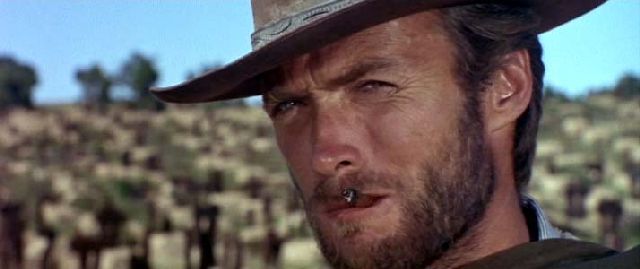The Good, The Bad and the Ugly (1966) 
“For Three Men The Civil War Wasn’t Hell. It Was Practice!”

Director: Sergio Leone
Cast: Clint Eastwood, Eli Wallach, Lee Van Cleef
Synopsis: A bounty hunting scam joins two men in an uneasy alliance against a third in a race to find a fortune in gold buried in a remote cemetery.
Watch this and other movies on Sky Cinema
The Good, the Bad, and the Ugly is a big, sprawling Western wrapped around a small plot in which all the characters are pre-occupied with getting their hands on what Alfred Hitchcock used to like to call a MacGuffin. In this case, the MacGuffin is a chest of gold coins buried in a cemetery, and the three men after it each embodies one of the qualities mentioned in the title. Actually, that’s not really true. If that was case the movie would be called The Bad, the Bad and the Bad, or The Bad, The Worse and the Downright Sadistic. Anyway, the plot is secondary to Sergio Leone’s vision of what the West was like – or what it should have been like: a vast, near-mythological arena in which every action, no matter how minor, had a kind of epic grandeur about it. He was wrong about the West, and Spain looks nothing like Texas or New Mexico or wherever the action is supposed to be set, but when all’s considered, that doesn’t really matter because Leone’s passion for his story and it’s characters is plain to see in every scene, and is completely, unavoidably infectious.
Clint Eastwood plays Blondie (The Good), a drifter, and partner of Tuco (Eli Wallach – The Ugly). The pair run a scam in which Blondie claims the reward for Tuco and then, having received the money, helps him to escape. When Blondie tires of Tuco’s complaining, he leaves him in the desert with no water, but Tuco survives and marches Blondie back into the desert in order to kill him. However, just as he is about to shoot Blondie, a runaway wagon full of dead rebel soldiers passes by. Tuco learns from the one surviving soldier the location of a cemetery in which a fortune in gold coins is buried, but while he is fetching water for the dying man, Blondie learns of the name on the grave, meaning that the mistrustful pair are forced to become partners.
Meanwhile, a character called Sentenza, known as Angel Eyes (Lee Van Cleef – The Bad), also learns of the treasure from a man who was trying to track down the soldier. When he learns that Tuco has adopted the soldier’s name, and is in possession of his tobacco box, Angel Eyes realises that he knows the whereabouts of the treasure. There then follows a protracted game of cat and mouse as each character attempts to double-cross the others so that they will be the first to locate the gold.
Although Clint Eastwood is the actor most closely associated with Leone’s Spaghetti Westerns, it’s actually Eli Wallach, as the roguish, irrepressible Tuco, who enjoys the more memorable role. For the most part, Eastwood’s character is simply called upon to respond to Tuco’s antics. It’s perhaps this animated counterpoint to Eastwood’s reserved demeanour that makes The Good, the Bad and the Ugly the best of the three ‘Man With No Name’ movies. Stylistically, the film is identical to A Fistful of Dollars (1964) and For a Few Dollars More (1965), filled with lengthy, largely dialogue-free, sequences in which very little happens, but which Leone nevertheless manages to fill with tension and suspense. Where it differs is in the interplay between Blondie and Tuco. Blondie may be a little less unscrupulous than Tuco, and while he might not trust him for a moment, you sense that there’s a kind of sneaking affection for the rogue that he shares with the audience. After all, it’s impossible to dislike a ruthless villain who travels into the desert beneath a ruffled pink parasol…
The Good, the Bad and the Ugly shares the same sense of epic history as Leone’s later Once Upon a Time in the West, but lacks the sense of time and place the latter film captured so effectively. But its set pieces mostly outshine those in Once Upon a Time in the West. Only Leone can successfully stretch out a sequence like the climactic three-way gunfight the way he does without irritating his audience. A key contributor to this ability is the soundtrack, provided by Ennio Morricone, which is by turn dramatic and romantic. It’s a strange misjudgment on Leone’s part than that he includes a Civil War battle scene in which a bridge is destroyed which adds nothing to the story – other than to establish the director’s anti-war sentiment – and badly disrupts the movie’s entire rhythm.
This minor gripe notwithstanding, The Good, The Bad and the Ugly is required viewing for any serious movie fan. Many who have come in Leone’s wake have attempted to emulate him and failed, not only because he possessed a unique and original vision, but because he had the elusive knack of being able to combine the epic with the intimate (Tuco’s confrontation with his brother, for example, a brief but key scene which humanises Tuco and gives us an insight into why he is the way he is without ramming the message down our throats), and seemed to have an instinctive sense for what worked and what didn’t.
(Reviewed 7th August 2012)
httpv://www.youtube.com/watch?v=WCN5JJY_wiA
